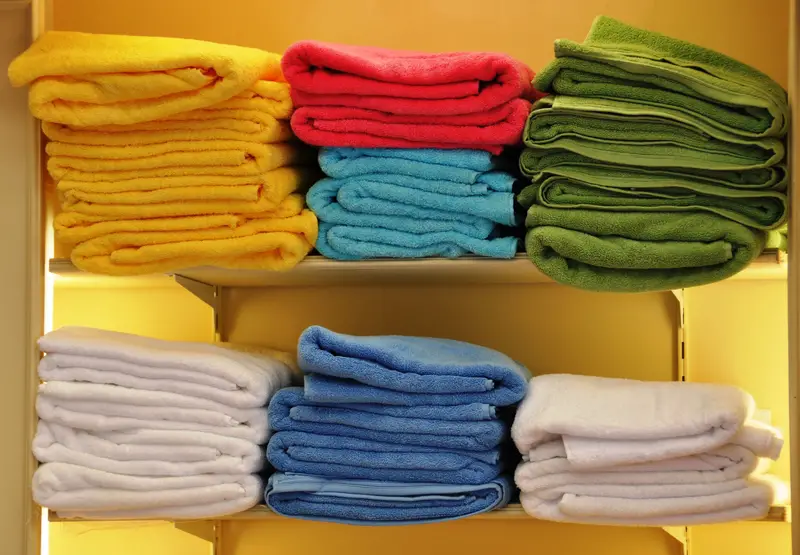Fresh towels straight from the store look perfect hanging in the bathroom, but using them immediately could be the biggest mistake you make. That silky-smooth feel you love actually comes from a chemical coating that manufacturers add to make towels appear more luxurious on store shelves. This coating blocks absorbency and traps bacteria, turning your investment into scratchy, smelly disappointments within weeks.
Skipping the first wash ruins everything
New towels come with a silicone-based finish that makes them feel soft in stores, but this coating prevents proper water absorption. The silicone creates a barrier between the cotton fibers and water, meaning your towel will push moisture around your skin instead of soaking it up. This coating also contains chemicals that can irritate sensitive skin and create an uncomfortable waxy feeling after each use.
Beyond the absorption issues, unwashed towels carry dirt, dust, and germs from shipping and store handling. Multiple people touch towels during shopping, and they collect particles from warehouse storage and transportation. White vinegar in the first wash breaks down the silicone coating while sanitizing the fabric. This simple step transforms your towels from decorative items into functional bathroom essentials that actually dry your body effectively.
Using too much detergent makes towels stiff
More detergent seems like it should mean cleaner towels, but excess soap builds up in fabric fibers and creates a stiff, scratchy texture. The soap residue acts like glue between cotton threads, reducing flexibility and making towels feel rough against skin. This buildup also traps odors and bacteria, creating that musty smell even after washing. Professional laundry services use precise measurements because they understand how detergent overuse damages fabric quality.
The solution involves using half the recommended detergent amount for towel loads and running an extra rinse cycle to remove all soap traces. Liquid detergent rinses out more completely than powder versions, reducing residue buildup. If towels already feel stiff from detergent overuse, wash them with just hot water and a cup of white vinegar to strip away accumulated soap. This reset process restores the natural softness and absorbency that makes towels comfortable to use.
Fabric softener destroys towel absorbency permanently
Fabric softener seems like the perfect solution for keeping towels fluffy, but it creates a waxy coating that repels water instead of absorbing it. The chemicals in fabric softeners coat individual cotton fibers with lubricants that make fabric feel smooth but prevent moisture absorption. Once this coating builds up over several washes, towels become practically waterproof and lose their primary function. The waxy residue also attracts and holds onto bacteria, creating persistent odors that regular washing cannot eliminate.
Dryer sheets cause similar problems by depositing waxy chemicals onto fabric during the drying process. Wool dryer balls provide a natural alternative that fluffs towels without chemical coatings. These balls bounce around the dryer, separating fabric and allowing air to circulate while reducing drying time. Skip fabric softeners entirely for towels, and use the vinegar-baking soda refresh method monthly to remove any chemical buildup that might accumulate from other laundry products.
Wrong water temperature fades colors and weakens fibers
Hot water seems like the obvious choice for getting towels really clean, but excessive heat damages cotton fibers and causes color fading. Temperatures above 140 degrees Fahrenheit break down the cotton structure, making fibers thin and brittle over time. Colored towels suffer the most from hot water washing because heat opens up dye molecules and allows them to escape during the wash cycle. This leads to faded, dull-looking towels that feel rough and scratchy against skin.
Warm water around 100-110 degrees provides the perfect balance for cleaning without damage. This temperature removes dirt and bacteria while preserving fiber integrity and color vibrancy. White towels can handle slightly hotter water because they don’t have dye molecules to protect, but even white cotton benefits from moderate temperatures. Check care labels before washing, as some premium towels require specific temperature ranges to maintain their quality and appearance over time.
High heat drying destroys cotton fibers quickly
Maximum heat settings dry towels fast, but they also break down cotton fibers and create thin, scratchy fabric. High temperatures cause cotton to shrink unevenly, creating bunched areas that never fully dry and become breeding grounds for mildew. The intense heat also makes fibers brittle, leading to tears and holes that appear suddenly after what seems like normal use. Over-dried towels lose their natural oils and become stiff, scratchy, and uncomfortable against skin.
Medium heat settings take longer but preserve towel quality and extend lifespan significantly. Remove towels while they still feel slightly damp, as residual heat will finish the drying process without over-cooking the fibers. Clotheslines provide the gentlest drying method, though towels may feel stiff without dryer movement. A quick five-minute tumble on no heat after line drying restores fluffiness while maintaining the benefits of air drying. This combination approach maximizes towel lifespan while keeping them soft and comfortable.
Hanging multiple towels together breeds bacteria
Doubling up towels on hooks creates moisture pockets where bacteria thrive in dark, damp conditions. The inner surfaces never fully dry, creating perfect environments for mold and mildew growth. This bacterial buildup causes musty odors that persist even after washing and can transfer to your skin during use. Towels that touch each other while drying also share bacteria and odors, contaminating clean towels with germs from dirty ones.
Each towel needs individual space to air dry completely between uses. Towel bars work better than hooks because they allow towels to hang flat with maximum air exposure. If space limits require hooks, rotate towels regularly so all surfaces get drying time. Towels that fall on bathroom floors should go straight to the hamper, as floor contact introduces new bacteria and dirt that washing may not fully eliminate. Proper spacing prevents cross-contamination and keeps towels fresh between uses.
Washing towels with other clothes creates lint disasters
Towels produce massive amounts of lint that sticks to other fabrics during washing and drying cycles. This lint transfer makes dark clothes look fuzzy and white, while delicate fabrics can be damaged by towel friction during wash cycles. Mixed loads also prevent proper cleaning because towels need different water levels and agitation than regular clothing. The weight difference causes unbalanced loads that can damage washing machines and reduce cleaning effectiveness for all items.
Separate towel loads ensure optimal cleaning conditions and prevent lint contamination of other laundry. Sort towels by color and weight to prevent bleeding and ensure even washing. New towels shed more lint during their first several washes, making separation even more critical during the break-in period. Mesh laundry bags can contain lint from particularly fuzzy towels while allowing proper water circulation. This separation protects your regular clothes while giving towels the specific care they need for optimal performance and longevity.
Leaving wet towels in hampers creates permanent odors
Damp towels sitting in closed hampers become bacterial breeding grounds that develop odors impossible to eliminate with normal washing. The trapped moisture and lack of air circulation create perfect conditions for mold and mildew growth deep within fabric fibers. These organisms produce compounds that bond permanently with cotton, creating persistent musty smells that survive multiple wash cycles. Wet towels also contaminate other laundry in the hamper, spreading odors and bacteria throughout your dirty clothes.
Always hang towels to dry completely before placing them in hampers, even if they’ll be washed within hours. The brief drying period prevents bacterial growth and protects other laundry from contamination. If towels develop persistent odors despite proper care, strip them with hot water, white vinegar, and baking soda in separate wash cycles. This intensive treatment removes deep-set bacteria and odor compounds that regular detergent cannot eliminate. Prevention through proper drying habits saves time and money compared to trying to rescue damaged towels.
Using towels for makeup removal stains them permanently
Makeup contains oils, pigments, and chemicals that bond with fabric fibers and resist normal washing methods. Foundation, mascara, and lipstick create stains that heat from washing and drying actually sets deeper into cotton fibers. These cosmetic stains also attract dirt and bacteria over time, creating discolored areas that make towels look dirty even when clean. The repeated rubbing motion of makeup removal also wears down fabric in specific areas, creating thin spots that tear easily.
Makeup wipes protect towels while providing more effective cleansing than rubbing with fabric. The specialized formulas in makeup removers break down cosmetic bonds that water and soap cannot dissolve. This approach also reduces skin irritation caused by repeated towel rubbing, which can spread bacteria and cause breakouts. Reserve towels for drying clean skin and hair, using dedicated cleansing products for makeup removal. This separation keeps towels looking fresh while providing better skincare results and extending towel lifespan significantly.
Taking care of towels properly starts with that crucial first wash and continues with smart daily habits. These simple changes transform towels from quick-wearing disappointments into long-lasting bathroom essentials that stay soft, absorbent, and fresh-smelling for years. Your future self will thank you every time you wrap up in a properly maintained towel.

